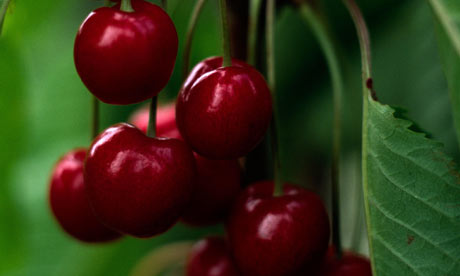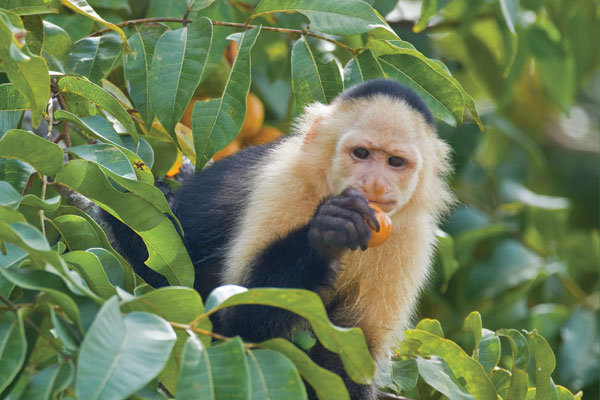|
|
The many benefits of cherries
Posted by:
Panchito
()
Date: November 10, 2014 12:41AM [www.lef.org]

 Re: The many benefits of cherries
Posted by:
rawgosia
()
Date: November 11, 2014 11:11AM Well, I look forward to having cherries again. These are grown locally in Tasmania and so they are really good. I also have some cherry trees in our garden. A couple of baby trees, and one that is getting bigger. We might get some cherries this year. I will have to put the netting on or the birds will get them first. 
RawGosia channel RawGosia streams Re: The many benefits of cherries
Posted by:
la_veronique
()
Date: November 11, 2014 11:25AM rawgosia
send some tasmanian cherry trees my way just throw it through a worm hole i'll catch it with a dreamcatcher i luvvv cherries! i like cherry juice too Re: The many benefits of cherries
Posted by:
banana who
()
Date: November 11, 2014 02:44PM Hey guys-
I love that cherries are so beneficial for us. The only rub is the price. I was in 7th heaven when Whole Foods offered them for one day only for about $1.99 a pound! Normally I think they went for 6X that at least. Another store had an even better deal but again, short-lived. Due to our hellacious winter of 2014, I believe that the cherry supply came in later than usual. I think it's supposed to be here in May and it was delayed until July. Does anyone know if buying frozen cherries would be somewhat akin to the fresh? I heard that only a third of the enzymatic activity would still be present but what about phytochemicals? Maybe it's time to see cherries as more medicinal, like gojis? Maybe that would make the price more tolerable...  Re: The many benefits of cherries
Posted by:
Anon 102
()
Date: November 11, 2014 03:57PM Those are not cherries in the 4th pic from top where the mostly black/some red monkey is eating. Those are a type of nut from a palm tree. You can see the palm tree behind. These nuts are great to eat. I have eaten lots of them back in the old country. Actually you don't eat the nut. After pulling the outer covering off with your teeth there is a creamy meat, kind of like ripe avocado in texture(not taste) and that's what you eat. I don't know the official name for it. I just know the local name. Re: The many benefits of cherries
Posted by:
Panchito
()
Date: November 11, 2014 05:44PM Frozen is actually better. I buy (Costco 4 lbs bags) frozen cherries. They are organic and are picked at the right time. You can have them all year round and the phytochemicals don't diminish when frozen.
[nutritionfacts.org]
Re: The many benefits of cherries
Posted by:
banana who
()
Date: November 11, 2014 06:07PM Panchito, what is the price? I will price them at Trader Joe's in a bit! I don't belong to Costco. Membership costs sometimes don't translate into savings so I would have to see about that. Re: The many benefits of cherries
Posted by:
jtprindl
()
Date: November 11, 2014 10:20PM Frozen fruit might be better than store-bought "fresh" fruit but it's not even close to fruit picked directly from the source. Re: The many benefits of cherries
Posted by:
Panchito
()
Date: November 12, 2014 02:30AM the worst cherries are the ones you don't eat  Re: The many benefits of cherries
Posted by:
la_veronique
()
Date: November 17, 2014 05:07AM cherries...
i personally think all of them taste good no matter what color or what kind if its cherry yellow or red or yellow red they are goin in my fridge cherries are smiles from heaven  Re: The many benefits of cherries
Posted by:
Panchito
()
Date: November 17, 2014 05:32PM And cherries enhances the body circadian rhythms, which helps achieve homeostasis and cure from diseases.
[nutritionfacts.org]
Re: The many benefits of cherries
Posted by:
Living Food
()
Date: November 17, 2014 05:44PM
This is extremely interesting, it means that fenugreek sprouts *might* have high levels of melatonin in them...this could account for some of their impressive benefits. Of course we can't draw any conclusions from this, but it is certainly something to look into. Benefits of Melatonin Re: The many benefits of cherries
Posted by:
The Sproutarian Man
()
Date: November 17, 2014 11:52PM Living Food Wrote:
------------------------------------------------------- > A few spices are pretty potent: just a teaspoon of > fenugreek or mustard seeds has as much as a few > tomatoes. > > This is extremely interesting, it means that > fenugreek sprouts *might* have high levels of > melatonin in them...this could account for some of > their impressive benefits. Of course we can't draw > any conclusions from this, but it is certainly > something to look into. > > Benefits of Melatonin Fenugreek is of extreme importance in a vegan diet to help create nutritional synergy I find fenugreek sporouts to be one of the most important sprouts of them all for various reasons. I have 10 tablespoons of seed 5 - 6 days per week. No need for deodorant when you have that much seed because the body smells like herbs. NOW....fenugreek is extremely important for many reasons, but one of it's most important functions in the vegan diet is to bring synergy in the diet by reducing the extremely high levels of manganese and copper present in virtually all diets so the copper - zinc ratio can be better balanced in order to pave the way for better EPA/DHA conversion. People say that the high iron levels could cause heart disease, but l say that the extremely high iron in fenugreek won't be properly absorbed because the high levels of manganese and copper in the vegan diet will reduce it absorbability. In effect, the high iron in fenugreek should balance out the manganese, iron and copper levels. I call fenugreek one of the great vegan diet balancers. The same goes with chia sprouts and hydrilla algae. They are the three great balancers of the vegan diet imo. Fenugreek and chia sprouts are the star balancers, and without those foods l think a vegan diet is so much worse off for many many reasons. Side Effect of Fenugreek Consumption (not a bad thing) [www.youtube.com] Fenugreek is such a highly nutritious food and packed with antioxidants. I have a write-up on why they are so important. I strongly suggest every vegan consume these sprouts as a staple. Nearly all nuts, seeds, fruits and vegetables have excessive manganese and copper, but the fenugreek will tame these inbalances in the vegan diet to create more synergy so it flows better. We want to do the best we can because the vegan diet is often highly unbalanced...so l say to people to bring in some key balancing foods so we can tame the savage beast within the vegan diet so more people can be sucessful vegans. www.thesproutarian.com Edited 2 time(s). Last edit at 11/17/2014 11:59PM by The Sproutarian Man. Re: The many benefits of cherries
Posted by:
CommonSenseRaw
()
Date: November 19, 2014 03:32PM Panchito Wrote:
------------------------------------------------------- > Frozen is actually better. I buy (Costco 4 lbs > bags) frozen cherries. They are organic and are > picked at the right time. You can have them all > year round and the phytochemicals don't diminish > when frozen. > > [nutritionfacts.org] > rsus-frozen-fruit-which-is-better/ > > I found two good studies comparing fresh to frozen > fruit. One on strawberries and one on raspberries. > They both found the same thing: “no > statistically significant differences between > the… for fresh and frozen strawberries” and > “It is concluded, therefore, that freshly > picked, fresh commercial, and frozen raspberries > all contain similar levels of phytochemicals and > antioxidants per serving.” > > In fact, frozen last longer than fresh, are > available year-round, and tend to be cheaper and > more convenient. If you look in my freezer, > normally it’s half frozen greens and half frozen > berries (though this time of the year it’s also > stuffed with 20 pounds of fresh dates!). Thank for the info. I went to Costco and got two bags of frozen cherries and frozen blueberries. They have plenty and surely will go back there. The natural hygiene folks claim that freezing destroys nutrients [www.rawfoodexplained.com] Edited 1 time(s). Last edit at 11/19/2014 03:33PM by CommonSenseRaw. Re: The many benefits of cherries
Posted by:
Panchito
()
Date: November 19, 2014 07:02PM freezing is not perfect but has many advantages. The most important one being able to freeze the fruits at the right time instead of premature harvest, long shipping, and chemical manipulation of color, etc. The proteins are not denatured like with high heat and it seems to work ok for cherries. Obviously, the fruit should be ripe before freezing. Some companies freeze the berries one at a time to avoid problems. It is also easier to find cheaper organic berries on bulk. And lastly, they are available all year round. To me the advantages outweight the dissadvantages. I've also seen organic mangos picked ripe. The are easy to add to smoothies or salads. The disadvantage is that you cannot see through the bag, and maybe the company does not do a good job picking the best or the best. You rely on them. But again, it is not that bad to pass up the benefits (organic, ripe, bulk cheap, etc). I look it as another option, not a good or bad thing. The best fruit is the one you eat, not the one you don't eat. There is perfect fruit somewhere but it is useless if you cannot get it. Re: The many benefits of cherries
Posted by:
CommonSenseRaw
()
Date: November 19, 2014 07:43PM You are correct. Frozen is better than nothing.
I had frozen cherries, frozen blueberries and some pomegranate for lunch today. I did buy a bag of frozen strawberries too but they are not coming out right when you let them sit for an hour. I guess those fruits with a lot water do not un freeze well. They are totally tasteless. Mango should be fine. will get mango next time Edited 3 time(s). Last edit at 11/19/2014 07:55PM by CommonSenseRaw. Sorry, only registered users may post in this forum.
|
|






